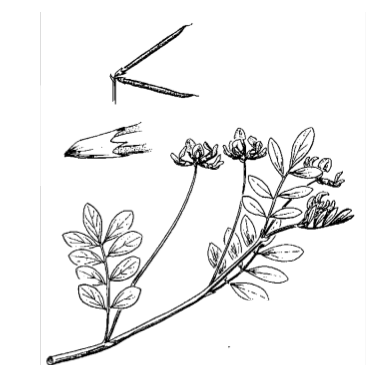
News/Reports
COSEWIC Assessment and Status Report on the Bog Bird’s-foot Trefoil Lotus pinnatus in Canada
Endangered–2004
Lotus pinnatus (bog bird’sfoot trefoil) is a lowgrowing, multistemmed perennial herb with compound, pinnate leaves. The pealike, yellow and creamcoloured flowers are borne at the end of a long stalk arising from the angle between the stem and leaf stalk. It is distinguished from other Lotus species by its perennial habit, papery stipules and yellow and white flowers. The umbel stalks are bractless or with a single membranous bract.
See the complete report in PDF at:COSEWICLotuspinnatus
Distribution
Lotus pinnatus is restricted to the west coast of North America and ranges from southeastern Vancouver Island, west of the Cascade Mountains and along the Columbia River Gorge from northwestern Washington to central California. This species also occurs sporadically eastward to Idaho.
Habitat
British Columbia populations of Lotus pinnatus occur in moist open meadows along the margins of creeks, in wet ditches or in seepages, where underground water comes to the surface. In all cases, the soils are shallow (< 15 cm), over gently sloping sandstone or conglomerate bedrock with abundant moisture during the growing and blooming period. The most commonly associated species include Mimulus guttatus, Triteleia hyacinthina, Plectritis congestus, Plagiobothrys scouleri, Veronica beccabunga ssp. americana and Montia parvifolia.
Biology
Lotus pinnatus is a perennial plant that sends up several shoots each spring. The flowers emerge in June and mature by early July, before summer moisture deficits reduce the plant’s productivity. Capsules begin to dehisce by midJuly, dispersing mature seed until August. Flowers likely require crosspollination to set viable seed, though pollinators have not yet been identified. The seeds have a hard seed coat that may delay the germination of some seed for several months or years.
iv
Population sizes and trends
There are seven known populations of Lotus pinnatus in Canada. Historic populations at two other sites could not be relocated and are likely extirpated. The total number of plants in Canada is between 1500 and 2000.
Limiting factors and threats
The viability of Lotus pinnatus in Canada is a concern due to the small number of known populations, habitat specificity, isolation from Washington populations, limited seed dispersal and the lack of protection on private land. Alterations to hydrology and erosion arising from intensive recreational use of primary habitat by offroad vehicles and invasive species are the main concerns for British Columbia populations.
Special significance of the species
The populations of L. pinnatus in British Columbia are at the northern extent of the geographic range of the species. Isolated peripheral populations are often genetically and morphologically divergent from central populations. The ability of a species to adapt to changing ecological conditions and therefore, its longterm survival, may rest on the conservation of these potentially genetically distinct peripheral populations (Lesica and Allendorf 1995).
Existing protection or other status designations
Provincially, Lotus pinnatus is redlisted (critically imperiled because of extreme rarity) as designated by the British Columbia Conservation Data Centre. Four occurrences for Lotus pinnatus are located on land that is privately owned; one site is protected within Ecological Reserve #142.(Woodley Range)
TABLE OF CONTENTS
SPECIES INFORMATION………………………………………………………………………………….. 3 Name and classification………………………………………………………………………………….. 3 Description……………………………………………………………………………………………………. 4
DISTRIBUTION ………………………………………………………………………………………………… 6 Global range …………………………………………………………………………………………………. 6 Canadian range …………………………………………………………………………………………….. 7
HABITAT …………………………………………………………………………………………………………. 9 Habitat requirements ……………………………………………………………………………………… 9 Trends ……………………………………………………………………………………………………….. 11 Protection/ownership ……………………………………………………………………………………. 11
BIOLOGY ………………………………………………………………………………………………………. 12 General………………………………………………………………………………………………………. 12 Reproduction ………………………………………………………………………………………………. 14 Survival………………………………………………………………………………………………………. 15 Movements/dispersal……………………………………………………………………………………. 15 Nutrition and interspecific interactions …………………………………………………………….. 15 Behaviour/adaptability ………………………………………………………………………………….. 16
POPULATION SIZES AND TRENDS…………………………………………………………………. 16 General………………………………………………………………………………………………………. 16 Extirpated populations ………………………………………………………………………………….. 20
LIMITING FACTORS AND THREATS ……………………………………………………………….. 21 SPECIAL SIGNIFICANCE OF THE SPECIES …………………………………………………….. 23 EXISTING PROTECTION OR OTHER STATUS DESIGNATIONS ………………………… 24 TECHNICAL SUMMARY………………………………………………………………………………….. 26 ACKNOWLEDGEMENTS ………………………………………………………………………………… 28 AUTHORITIES CONTACTED …………………………………………………………………………… 28 LITERATURE CITED ………………………………………………………………………………………. 29 BIOGRAPHICAL SUMMARY of the REPORT WRITER ……………………………………….. 32 COLLECTIONS EXAMINED …………………………………………………………………………….. 33
List of figures
Figure 1. Illustration of Lotus pinnatus…………………………………………………………………. 4 Figure 2. Distribution of Lotus pinnatus in North America. ……………………………………… 6 Figure 3. Distribution of Lotus pinnatus in British Columbia. …………………………………… 7 Figure 4. Destruction of habitat caused by allterrain vehicles at Harewood Plains ….. 22
List of tables
Table 1. Populations of Lotus pinnatus in British Columbia…………………………………… 17
See the complete report in PDF at:COSEWICLotuspinnatus

